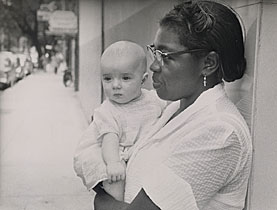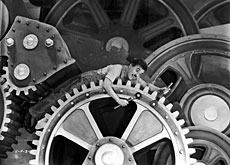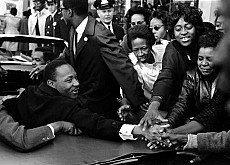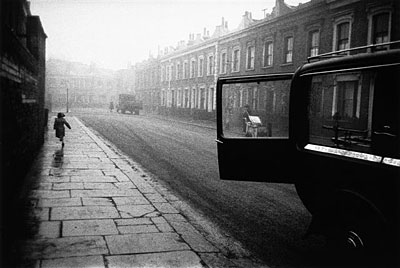Seeing America through the lens of Robert Frank

Half a century after the Swiss photographer Robert Frank published his controversial book The Americans, a retrospective of his work has opened in the United States.
Frank, a Zurich native, was criticised for his book documenting societal problems in the US in the 1950s, some of which are still unresolved in the country today.
The National Gallery of Art in Washington DC is the first of three major US museums to showcase an exhibition of his work, timed to coincide with the 50th anniversary of his photographic book.
The display, which includes input from Frank and his personal images and records, emphasises his innovative role in the evolution of photography.
“This photography book is considered to be the most important since the Second World War, even of the 20th century,” Sarah Greenhough, head of the photography collections at the National Gallery, told swissinfo.
“Robert Frank’s book offered a radically different view of American society of the 1950s, a really contrasting vision to that projected by the US magazines of the era such as Life, which, in turn, conveyed an optimistic and positive image of America,” she explained.
“Furthermore, the way Robert Frank photographed broke with tradition, because his approach was more free and spontaneous.”
Swiss and American traits
Frank began studying photography in his hometown of Zurich in 1941. He was hired by the advertising photographer Michael Wolgensinger and was influenced by the Swiss photographer Gotthard Schuh, and especially Jakob Tuggener.
“Tuggener’s book, Fabrik, really influenced Robert Frank. In particular this way of creating a sequences of images that deal with major issues via the image and the relationship between images, and not through the text,” Greenhough said.
“Frank is both very American and very Swiss and this is very apparent in The Americans.”
“He is very thorough and very organised when it comes to numbering and labelling his many films and it is something he learned from Wolgensinger in Switzerland.”
“But he also needs chaos around him, an abundance of images around him on the floor to choose from, and that is something he learned in New York from the beatniks, poets and painters of abstract expressionism.”
Too personal
After migrating to the US in 1947, Frank was hired by Harper’s Bazaar magazine. But he soon became frustrated with the commercial requirements of the American press and left the magazine.
“Frank always wanted to be recognised by Life magazine,” recalled Greenhough. “For years, Robert Frank’s photos were refused by Life and bought by European publications.”
“He had trouble getting published in the United States because editors felt that his photographs were too personal and expressed his ideas, rather than theirs.”
He was however supported by colleagues and leading figures in the US art world. Notably, the photographer Walker Evans and Edward Steichen, the director of the photography department at the Museum of Modern Art in New York, who helped Frank get a grant from the Guggenheim Foundation to travel across the US and research his book.
Profound impact
Greenhough says The Americans, with its 83 photographs, “digs beneath the surface of the American way of life and reveals a deep sense of alienation”.
Badly received in the US, the book was first published in Paris in 1958 and in New York a year later. At its US release, Greenhough says Frank was “vilified and despised as he was deemed be anti-American”.
Nevertheless it is a publication that remains relevant to modern America.
“It is wonderful that our exhibition coincides with the arrival in the White House of Barack Obama, our first black president, whose election shows that America has changed to some extent,” said Greenhough.
“But at the same time I am shocked that in 2009, 50 years after the publication of Robert Frank’s book, America still struggles with the same problems: racism, poverty, scepticism of political leaders and the alienation of individuals, and all that in a consumer society that has been developing even more in this way since the 1950s.”
On an artistic level, the impact of The Americans has also persisted over the years.
“This book profoundly changed the course of photography in the United States and around the world,” Greenhough stated.
“This book has taken the tradition of the photo documentary by people like Walker Evans, which was characterised by a cold and objective style, and transformed it with a more personal and subjective approach.”
swissinfo, Marie-Christine Bonzom in Washington
Looking In: Robert Frank’s The Americans, was organised by the National Gallery of Art with input from Frank and marks the 50th anniversary of the US publication of his book.
The National Gallery of Art has an impressive collection of works by Frank, including unique photographs dating back to his early career in Switzerland. All the photographs from the book are on show, as well as an anthology of his work and a film he has produced specially for the exhibition.
The exhibition runs in Washington DC until April 26, and then moves to the Modern Art Museum of San Francisco from May 17 to August 23 and at the Metropolitan in New York from September 22 to December 27.
Robert Frank was born in 1924 in Zurich into a Jewish family. In 1941 he began studying photography under two Swiss professionals, Michael Hermann and Segesser Wolgensinger.
Six years later migrated to the US and settled in New York. With support from the American photographer Walker Evans, he obtained a grant to do a photographic trip across the US. In 1955 and 1956, he travelled through 30 states, amassing 28,000 images.
The Americans, the fruit of this journey, was first published in Paris in 1958 by Robert Delpire, and a year later by Grove Press in New York. Beat writer Jack Kerouac contributed the introduction to the US edition of the book, a factor that later helped boost its popularity.
As well as being one of the main visual artists to document the Beat poet subculture, Frank also made films, including a 1972 tour documentary of the Rolling Stones that was banned from being shown in public.
Later photography work included the more autobiographical book, The Lines of My Hand, and collages. The Americans has been recognised as his most important work. The book was reissued in 2007 by the Steidl publishing firm with the original photographs revised and recropped by Frank.

In compliance with the JTI standards
More: SWI swissinfo.ch certified by the Journalism Trust Initiative



You can find an overview of ongoing debates with our journalists here. Please join us!
If you want to start a conversation about a topic raised in this article or want to report factual errors, email us at english@swissinfo.ch.